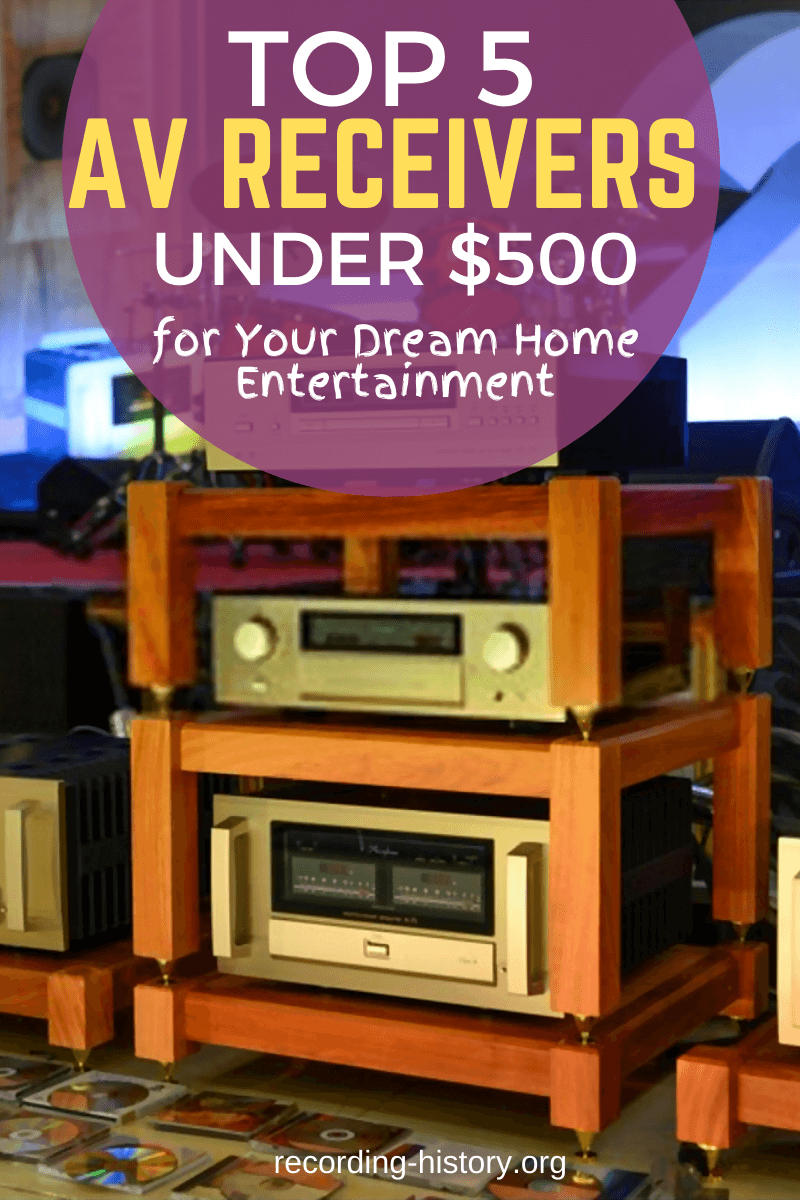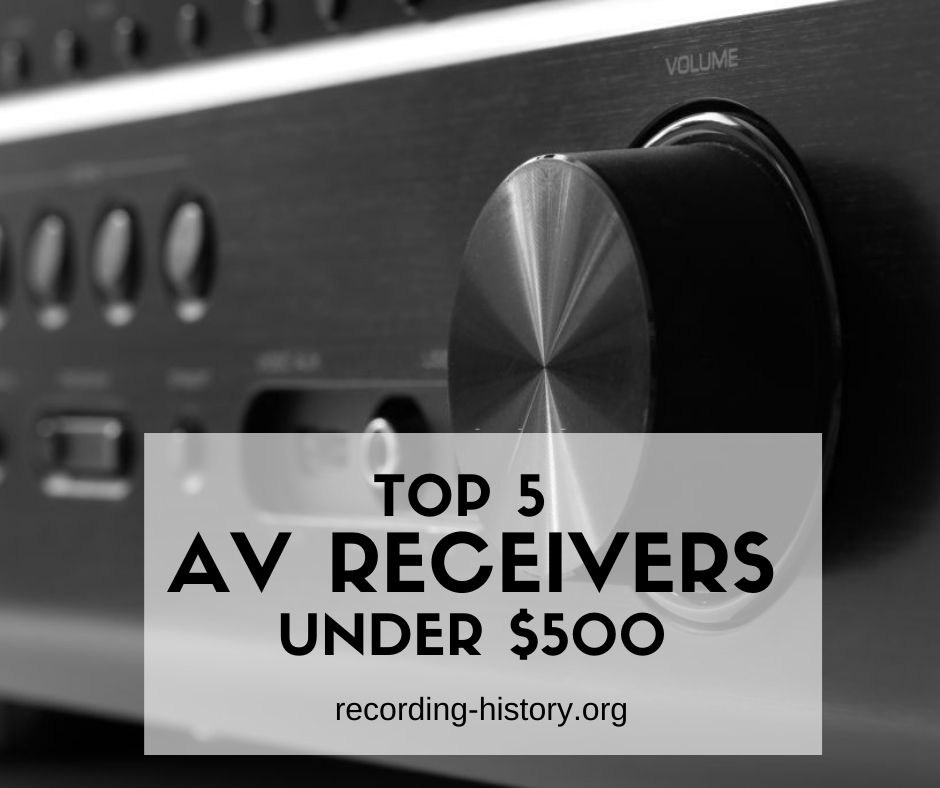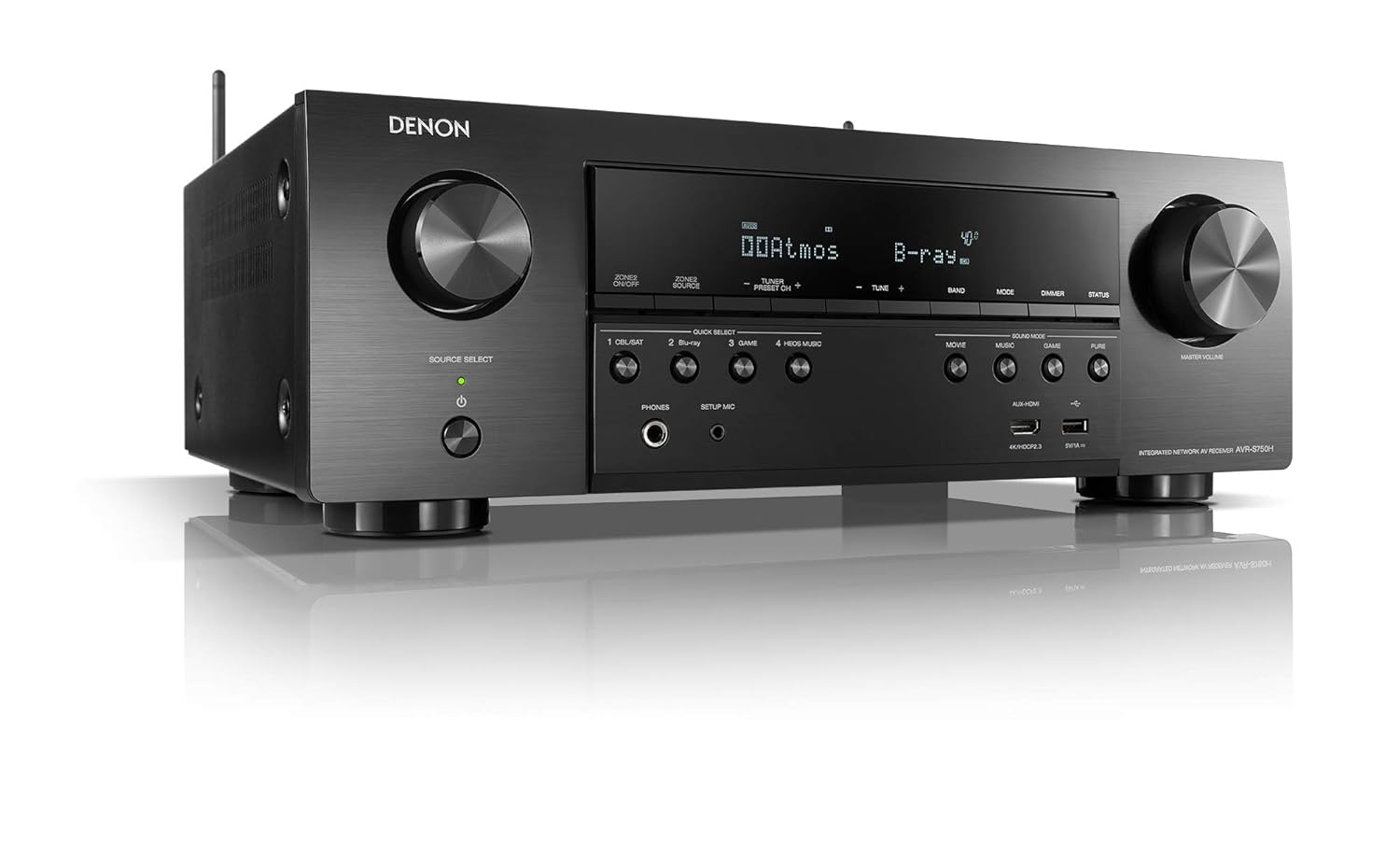5 Best AV Receivers Under $500 for Your Dream Home Entertainment
Home entertainment is often an underrated investment for home improvement. It makes everything better, more calm and the home homier because it gives family and friends some time off to relax and unwind.
AV receivers are easy to understand. AV stands for audio and video which means that AV receivers would receive audio and video signals from various sources and the channel them to loudspeakers and display monitors like televisions or projector. Through this, homes can have its entertainment system.
It is hard to look for the best AV receivers if you do not know what to look for. To help you with this, here are some of the AV receivers that you can check out later.
5 best AV receiver under $500
Speaking of the best AV receivers for your dream home entertainment, here are five of the best buys that you could consider for your AV receiver choice.
1. Denon AVR-S750H
This one features a 7.2 channel which is already high-end being able to support 7 channels and two subwoofers on 165 watts. What we also love about this is its 4K UHD video and HDR support which give ultra-clear videos and images with exceptional color and contrast. Most importantly, it supports more than 12 audio and video streaming applications like Sirius, Spotify, Amazon Music, Netflix and more.
Pros:
- Equipped with Dolby Atmos for extreme surround sound and virtualization technology.
- Built-in HEO support for MP3, WAV, FLAC and DSD formats and other wireless streaming apps for both audio and video files like Spotify, Netflix, Apple Airplay, Alexa and Google Assistant.
- It has an on-screen setup assistant, and additional 6 HDMI ports.
- New stock model (2019) with innovative features.
2. Onkyo TX-SR373
It supports a 5.2 channel which includes five satellite channels and two subwoofers. It is also equipped with a wireless Bluetooth receiver for seamless connectivity of gadget to receiver that copies whatever is played in the laptop or mobile phone and optimizes it for better audio and visual experience.
This innovation was made possible by the Qualcomm aptX codec which is an enhancement of the Bluetooth wireless technology for AV receivers.
Pros:
- Decodes Dolby TrueHD and DTS-HD Master Audio for multichannel formats for both audio and video files.
- Supports up to 2 HDMI connections with 4K Ultra HD resolution for clearer graphics and images.
- Equipped with an Audio Return Channel (ARC) for TV broadcast amplification.
- Equipped with AccuEQ which measures and corrects audio in various speaker distances and frequencies to ensure surround-sound.
- Comes with an enhanced Bluetooth technology and an added USB input.
3. Yamaha RX-V683VL
It supports a 7.2 channel of 7 satellite channels and 2 subwoofers to ensure better audio and visual experience within the confines of your home. It can be used for wireless and plug-in configurations so it is basically portable.
It complements well with Alexa and it is built with Dolby Atmos and DTS:X which can make audio and visual experiences a high-end one in a coverage of more than 9 rooms through its MusicCast feature.
Pros:
- Comes with a Zone 2 audio with extra bass, volume equalizer, main zone sync and party mode inputs to make way for a second room audio.
- Equipped with MusicCast, Wi-Fi, Bluettoth, TIDAL, Deezer and other music streaming platforms.
- It can be connected to a turntable through its phono input and has the Yamaha exclusive YPAO sound optimization made for home entertainment.
4. Sony STR-DH790
This one also has a 7.2 channel receiver that supports 7 satellite channels and 2 subwoofers.
It comes with wireless technology through the Bluetooth receiver and an accompanying Dolby Atmos surround-sound technology for a better, more upgraded home theater experience.
The visual experience out of this one is also very sophisticated as it features 4K HDR, Dolby Vision and DTS:X.
Pros:
- It has a slim, ergonomic design for portable, wireless connectivity.
- It can cover a wide room with the extreme surround sound and graphic and image processing thanks to Dolby Vision and DTS:X.
- Accurate in signal decoding and no delay in audio and visual crossovers because it is equipped with 3 digital processors.
5. Yamaha RX-V485
This is less portable than the V683VL but with smaller bandwidth of 5.1 channels or five satellite channels and one subwoofer.
Nonetheless, it is as good as all the others in the list as it is also equipped with innovations such as the MusicCast which perfectly supports Alexa, Apple gadgets and Google Assistant. The MusicCast also supports up to 50 speakers to ensure that home-theater surround sound.
Pros:
- It supports a wide range of audio and visual formats and platforms like Pandora, TIDAL, Sirius, Deezer, Spotify, Netflix and Napster.
- Its HDMI input has HDCP 2.2., 4K ultra HD resolution, HDR 10 and Hybrid Log-Gamma for an optimized visual experience.
- Compatible with both MusicCast 20 and MusicCast 50 wireless streaming speakers.
- Equipped with the Yamaha exclusive YAPAO which analyzes the acoustic balance of the room and auto-adjusts it to the perfect sound.
The verdict
Honestly, it was a battle between the Onkyo and the Yamaha RX-V485 but the winner for this is Onkyo because of two reasons: level of innovation and functionality.
In terms of innovation, it is portable with many added specifications such as the ARC, the AccuEQ and its support to key wireless outputs like Bluetooth, USB and the QualComm technology all for a better surround-sound system and HD resolution visuals.
These are well-thought innovations that truly separate it a notch higher level than the rest.
Buying Guide
It is time to narrow down your choice through these buying guides. So what are the key features to consider when you finally buy that AV receiver? And how do you set it up for you to get the best sound?
Key features to consider when buying an AV receiver
When it comes to key features, there are four very important things to consider: connectivity, audio features, video features and networking features and here are the reasons why.
#1. Connectivity
What is the use of having an AV receiver if you only have limited ports to plug it on? The first thing to consider would be the number of ports it could connect with.
A good AV receiver should be able to connect to a wide range of channels besides audio and video ports. For starters, choose AV receivers that could also support HDMI, Ethernet ports and must have updated accessory ports for Bluetooth, iPod docks and Sirius radio.
#2. Audio Features
At a standard rate, good AV receives should support a 5.1 channel sound which means that it should be able to support 5 satellite speakers and one subwoofer.
AV receivers that can support a 7.1 channel sound is already a major plus. Another thing to consider for the audio feature is the power that it could accommodate.
Low end AV receivers could only accommodate up to 90 watts but high-end ones could go up to 140 watts. Most important of all, almost all AV receiver models now are infused with the Dolby Pro Logic or the surround sound technology so perhaps, this is the first thing that you should check on the box before buying.
#3. Video Features
For the video features, upscaling and interface features are musts. Upscaling refers to the video resolution the Av receiver could process.
A good AV receiver should be able to upscale video to up to 1080 HD. High-end AV receivers do not only convert videos from analog inputs but also upscale videos from HDMI inputs and other digital video.
As for the interface, low-end AV receivers have a text-based on-screen selection while high-end ones have a graphical on-screen selection for easier navigation.
#4. Networking Features
This one is the most recent innovation that redefined AV receivers’ functionality. The best AV receivers at present would be the ones that could process and find global and local videos and audios through various channels such as the Ethernet, mobile phones and other gadgets. But how would you know this?
All you have to do is to look for that DLNA certificate which stands for Digital Living Network Alliance. This certifies that the AV receiver can access any device that is accessible in the network.
How to setup your AV receiver and get the best sound
The next important thing to know is how to setup the AV receiver to bring home that theater-like experience. There are a few easy steps that you could do on your own, right away.
#1. Connecting The Right Plug At The Right Place
You could easily get confused with the number of plugs inside the AV receiver box that is why you need to have the user’s manual right beside you when you start plugging it all in.
Most AV receivers are labeled and color coded, some are just color coded. You have to be very careful here and read each label since all the cords and plugs will have labels on it.
Some AV receivers have more plugs than you can imagine especially for those models with more than one HDMI inputs so you need to be patient with this.
#2. Calibrating The System
This is the lengthiest and most crucial part in setting up your AV receiver. The box should have a set-up mic plug to it which will allow you to run an auto-calibration test so that you can measure the performance of the speakers in various distances and for you to know if you will need amplifiers.
There will be on-screen instructions and do not be wary if it does not sound right the first time. Do not stop adjusting until you get the right sound and the surround sound experience.
This may take a bit of your time but it will be all worth it. There are also mobile apps now that will help you measure sound pressure. For more detailed information about this, you may check this video from Home Theater Hobbyist.
#3. More Plugging
The last part is about setting it all up, connecting it to your audio and video channels. First thing to consider here is your power outlet.
Check the wattage and don’t just plug right away. Also make sure that your amplifier or speaker connectors are in place and the HDMI plugs and HDTV cables are complete for your monitor set-up. If everything goes well after this, say welcome to your home theater.
FAQs
Are AV receivers worth it?
The answer to this is very simple: it depends on the purpose of the person in buying it in the first place. If the goal is really to have a better home entertainment experience then yes, AV receivers are worth it even though they are fairly the same but if you think AV receivers could still improve and be innovated further then, you need to rethink.
How long should AV receivers last?
At a standard rate, well-built or high-end AV receivers are built to last for a maximum of 10 years but in reality, you might be compelled to replace AV receivers after 4 years because of the fast technological crossover among these types of appliances. And just a piece of advice, replacing your AV receiver now is a good investment because of the level of innovation that it is infused with right now.
Does a smart TV need a receiver?
This question should be referenced in terms of purpose because honestly, it can but not necessarily need. AV receivers have new channel ports where you could connect your HDTV cable to for a 1080 HD projection.
With the surround sound that it could also offer, again, if the goal is to create a home entertainment, go for that AV receiver for your smart TV but if you just need it for other things beyond this, speakers might do.
How many channels do I need on my receiver?
Well it depends again on the type of home entertainment you want to achieve and of course the budget that you have. Typically, standard AV receivers would have a 3.1 channel or 3 satellite channels with 1 subwoofer.
The more sophisticated the home entertainment you want to have, the more channels you will need. You need to know however, that a 5.1 channel is already good enough but if you want to elevate it further, a 7.1 or 9.1 channel system is already very high-end.
When should I upgrade my AV receiver?
Your AV receiver should upgrade as you upgrade your gadgets and appliances where you will need it. This is the basic consideration that should be established first before anything else. But you must also be very careful in upgrading because newer models of mobile phones, gadgets and smart TV might have different cable requirements that might not be present in your currently upgraded AV receiver.
Conclusion
AV receivers are really essential for homes that really want to invest in home entertainment due to many reasons.
But choosing the best one is not child-play. You need to invest ample time to gain more knowledge on what to choose and why you should choose it, knowledge of what you want and how it will match your home and attention to detail as to what plugs should stick in, the need for an upgrade in your gadgets to suit the Av receiver and most importantly, the level of sophistication you want to achieve for your home entertainment.
With all of these in mind, you really need to invest time, effort and most importantly money in choosing the best AV receiver you need.









